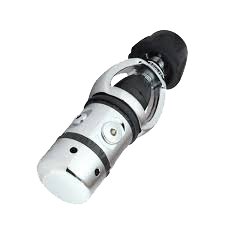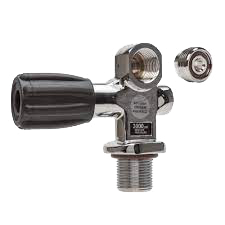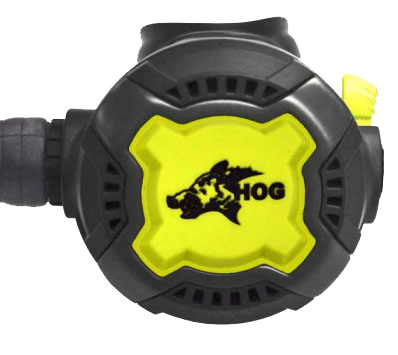| Buying your first set of regs can be time of excitement and a time of dread, there are so many brands and so many kinds, which do you choose? Balanced or unbalanced? Piston or diaphragm? Yoke or din? Will you be in cold water or diving in the Caribbean? Are you looking for something light and travel friendly or a tank that can withstand heavy use. The choices seem endless but if you look at a few key things you can narrow that choice down dramatically. | |||
 |
|||
Types of first stagesRegulators no mater the brand function basically the same with the exception of a select few models. Most are balanced or unbalance, piston or diaphragm. Balanced |
|||
 |
Piston Regulators are considered a solid workhorse design. They can be either balanced or unbalanced and are relatively cheap. They are a great choice for warm water divers but not cold water where they can freeze up. | ||
 |
Diaphragm first stages are recognizable by a soft rubber disc on one end. It may have a plastic protector over it but on close inspection you will find it. Diaphragm regs can be balanced or unbalance but most choose the balanced versions. They tend to be more complex and are more resistant to freeze ups in cold water diving. Many get this in an environmentally sealed version for added protection from the elements. | ||
|
Yoke or din? Yoke and din are the type of connectors that attach to the tank. Yoke (image A) has a large knob on top can be readily found at any dive shop. It is a standard first stage to tank connector in most countries, it connects to a valve (image D) with a small hole and a tank oring visible. This kind of connector can be used with LP (Low pressure tanks) and HP (high pressure tanks) as long as the yoke has a sufficient pressure rating. That rating can be found in your first stage manual. but most avoid yoke with HP tanks for this reason. A draw back of yoke is the o ring in the valve is prone to leaks and failue if not manintained. Most carry several spare yoke valve o rings, they are inexpensive and found in any dive shop. See Save A Dive Kit. Din, (image B) is becoming more popular and is common in Europe and with technical diving. It commects to a valve (image C) with a large threaded hole, the o ring is on the first stage itself and very rarely fails. It can be as is used with HP tanks or with LP tanks using an adapter (image E). |
|||
 |
|||
| Some tanks come with what is called a pro valve. This allows you to use din or yoke by unscrewing a dounut in the tank valve using a hex key. The yoke o rings in these type of valvles tend to be more reliable. Pro valves are becoming popular with many divers converting their yoke first stages to din with conversion kits. |  |
||
Types of second stagesLike first stages there are balanced and unbalanced second stages . A balanced first stage can be used with an unbalanced second stage and vise versa. Some people mix them for several reasons but there is no right or wrong combination. Second stages also come in adjustable versions where you can manually adjust the breathing effort with a knob. Many confuse this know with the Venturi lever, a small handle that moves a short distance It can assist breathing effort somewhat but tends to cause free flows when assist is in effect. |
|||
 |
Hog balanced second stage with Venturi level and breathing effort adjustment knob |  |
Hog balanced second stage octo with just the Venturi lever |
| Second stage Octo
In the images above, you see the octo is different than the primary regulator not just in color but in features. This is mainly to save costs. Since the octo is used just for emergencies and for a short duration, its feature do not need to be as robust as the primary second stage. Many kits only include the first stage and primary second stage for this reason. You can chose any regulator for your octo, your budget is the limit. |
|||
Scuba Brands, which to buy?There are many different brands of regulators in different sizes, shapes and colors. Features vary from brand to brand with models geared for beginners to experts. Some brands like Apeks and Dive Rite market themselves to technical divers while brands like Cressi and Aqualung target beginner to intermediate. Then you have brands like Hollis and Scuba pro that target all markets. I learned when I became a certified open circuit technician, under the hood these regs are virtually the same. |
|||
 |
|||
|
Many regulator designs are licensed out to companies and they make small modifications while keeping functionality. For example to adjust the cracking pressure on a Hollis second stage you need a flat tip screwdriver, but to do the same for a Hog reg you need a hex key. Unless a regulator is made of titanium, there really is no reason to top of the line prices. Some have loyalty to brands and swear by them, I was a Hollis guy for years then tried Dive Rite and eventually settled on the cheaper Hog regs. The size and weight of regulators is also a factor. Brands like Cressi, Mares and Hollis make very light weight regs great for travel. Hog and Dive Rite make tanks that can survive just about any underwater environment. Pick what regulator suits your diving needs. Support is another big thing to think about when buying regulators, does your local shop service your brand? Is your brand so obscure like WMD regs, service parts may be hard to come by? Are service kits for your regs sold at a premium or is the cost included in manufacturers recommended service? All things to consider. So now that you know the basics about regulators, shop around and find whats right for you. Rent and try if you can, look for package deals but don't be afraid to custom tailor your kit. If you are really interested in how regulator work, take the PADI equipment specialty course. This course won't make you a service technician but it will go more into detail about the things I discussed here. Another great resource is "Scuba Regulator Savvy" by Pete Wolfinger, its a must have if you want to know how regs work. Happy shopping! |
|||